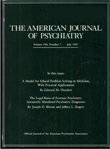A controlled study of lifetime prevalence of affective and other psychiatric disorders in bulimic outpatients
Abstract
The authors used structured diagnostic interviews to assess the lifetime prevalence of psychiatric disorders, by DSM-III criteria, among 70 women: 51 outpatients with active bulimia and 19 nonpatient subjects with remitted bulimia. Comparison groups consisted of 24 female outpatients with major depression and 28 nonpsychiatric control subjects. The active and remitted bulimic subjects closely resembled each other, with high lifetime rates of major affective disorder, anxiety disorders, and substance use disorders. Atypical depression was equally common among subjects with major affective disorder in all groups. These results are consistent with previous studies suggesting a phenomenologic relationship between bulimia and major affective disorder.
Access content
To read the fulltext, please use one of the options below to sign in or purchase access.- Personal login
- Institutional Login
- Sign in via OpenAthens
- Register for access
-
Please login/register if you wish to pair your device and check access availability.
Not a subscriber?
PsychiatryOnline subscription options offer access to the DSM-5 library, books, journals, CME, and patient resources. This all-in-one virtual library provides psychiatrists and mental health professionals with key resources for diagnosis, treatment, research, and professional development.
Need more help? PsychiatryOnline Customer Service may be reached by emailing [email protected] or by calling 800-368-5777 (in the U.S.) or 703-907-7322 (outside the U.S.).



